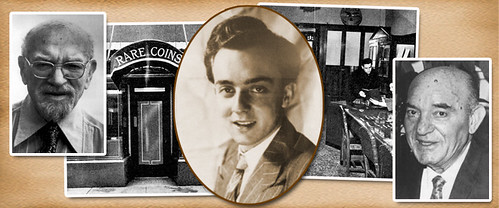
PREV ARTICLE
NEXT ARTICLE
FULL ISSUE
PREV FULL ISSUE
HARVEY STACK'S NUMISMATIC FAMILY, PART 35Harvey Stack's blog series focuses on living in a numismatic family. Here is part 35. Thanks, Harvey! -Editor

As 1964 began, Stack’s was coming off a very successful year in 1963. However, the new year was to bring various challenges to the coin hobby. First of all, Congress realized making U.S. coins – dimes, quarters, and half dollars -- was providing the silver almost at market price. From 1961 to 1963 the price of silver rose by some 20% and the Mint was virtually “giving away” the coins at close to or slightly above the value of the silver in each coin. So, Congress decided to start issuing dimes and quarters after 1964 in a clad metal and also to reduce the amount of silver in the half dollar by 40%. Meanwhile, earlier coins which were 90% silver in many cases increased in value as the price of silver rose. Traders in precious metals started to buy up standard silver coins and store them away for future sale and possibly melting. This became a distraction to the numismatic hobby. Silver speculators, including the famous Hunt family of Texas, invested in silver coins on speculation. Dealers were flooded with orders to provide silver coins to those who felt the future market would be favorable, and general interest in collecting was deterred by this speculation. Even those who collected classic coins like Morgan silver dollars, thought that the market for silver might go up enough to increase the value of the collections. So many held back from selling either by private sale or at auction. This interest in precious metals was also evident for gold coins during that year, increasing the demand for what could be acquired here in the United States as import regulations remained challenging. Adverse publicity affected the auctions of some current collections. We had sales almost every month of 1964, but with the exception of a few, most were general collections, causing collectors to have some trouble filling out their want lists. One of the highlights was the Philip Ward Collection of United States and Foreign Coins, in gold, silver and copper. It was a super collection of worldwide coins and appealed to buyers as a "real old-time collection." It was not full of high price rarities but was a basic collection of quality coins, providing us the opportunity to help quite a few of our clients. The collection formed by “Irl Baker" was an outstanding offering of United States gold, silver and copper coins that contained some classic rarities. The other collections were much smaller, but for some of our clients offered a chance to build on what they had already collected. Another factor that influenced the coin business was the tightening by the Treasury's restrictions on importing gold coins without a license, overseen by the Office of Gold and Silver Operations (OGSO). This import licensing was required for all coins imported into United States at the Post Office, Custom House and even for people who bought gold coins overseas and returned carrying them. The rules and regulations were so oppressive that they slowed the importing of gold coins. The problem was that the OSGO never published a list of what could clear Customs and what was prohibited. Dealers and collectors were confused by the lack of clarity and distressed when they tried to bring gold coins from overseas for sale or personal collections. It seemed to some, including me, that the OSGO made up the rules as coins were presented to them for licensing. These rules and restrictions encouraged some to smuggle coins and buyers had to exercise great care not to buy illegally imported gold coins. This had a very damping effect on collecting as others experienced the difficulty of the licensing procedure. Stack's had the perfect way to test the import regulation, and in my next article, I will tell the story of how that came about. To read the complete article, see: To read the earlier E-Sylum article, see: THE BOOK BAZARRE
Wayne Homren, Editor The Numismatic Bibliomania Society is a non-profit organization promoting numismatic literature. See our web site at coinbooks.org. To submit items for publication in The E-Sylum, write to the Editor at this address: whomren@gmail.com To subscribe go to: https://my.binhost.com/lists/listinfo/esylum All Rights Reserved. NBS Home Page Contact the NBS webmaster 
|